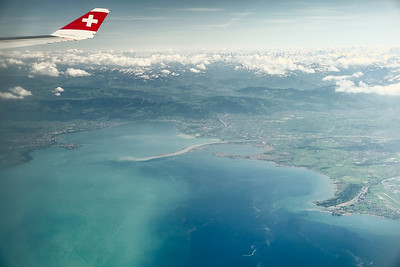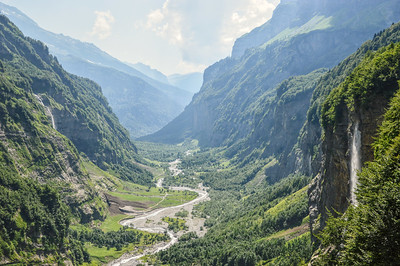Some years ago, I was a student of École Normale Supérieure in Paris. I was lucky to have excellent teachers in tectonics, seismology, atmospherics, and many other disciplines of the geosciences. And yet, I quickly became passionate about a topic barely taught there: geomorphology. The study of the shape of the Earth, or in other words topography, and the processes that explain it.
Fascinating geomorphology
In the spring of 2007, I had my first experience working on a research project. I tried to numerically reproduce the surface morphology of Greece’s Sparta fault scarp, a site that I only visited much later by bicycle in autumn 2020. My fellow students soon tagged me as “the geomorphologist”. The nickname was teasing: next to the primitive equations of meteorology, the linear algebra of seismic tomographic inversions, and the enigmatic phase diagrams of petrology, half-guessed geomorphological formulae had the looks of a pseudoscience.
Of all landscapes, I was most attracted by fjords and alpine valleys formed by ancient glaciers. I felt, and still feel today, that glacial landscapes hold a kind of ancient secret yet undeciphered. Thus in 2008, I begun sending emails about the world to look for an internship in glacial geomorphology. I settled for the first response, which was also the only one, and moved to Trondheim, Norway.
I still regard this period as one when I learned most about my future job as a researcher. But perhaps the most difficult lesson was this: glacial geomorphology is almost always sketchy, uncertain, “soft” science. Glacier motion in itself is so complicated, that theories on abrasion and plucking of the bedrock beneath them seemed hopeless. So in 2010, starting my doctorate, I put aside glacier erosion to just focus on ice flow physics alone. As I learned the hard way during the several years that followed, this was complicated enough.
It is only much later that I came back to the topic of glacier erosion. Last summer, my colleague Ian Delaney and I published a research paper on last-glacial-cycle glacier erosion in the Alps. Collaborating online with Ian, I prepared the paper in a holiday rental with stuff I carried on my bike, an interesting adventure on its own, perhaps for another post.
Between 2008 and 2021, much progress had been made on glacial geomorphology. Complementing more accurate measurements of glacier speed from GPS stations and satellites, researchers had tried different ways to quantify the amount of sediments produced by glaciers. Correlating the sediment volumes with glacier velocities, they deduced empirical erosion laws, mathematical formulae linking glacier speed and erosion based on field observations rather than hard-to-prove theories on subglacial processes.
Do large glaciers erode more?
Because I had a detailed reconstruction of glacier basal velocities from my 2018 study on the last glacial cycle in the Alps, I decided to apply these erosion laws to my data. This was a simple calculation not taking into account topographic change, sediments or river erosion, so reviewers suggested that Ian and I call the result a glacier erosion potential. The result is shown in the animations below.
This first animation is an attempt to visualise the time-evolving patterns of Alpine Glaciers erosion potential from 120000 years ago to the present. The erosion law in this video is based on measured glacier sediment accumulations in Patagonian and Antarctic Peninsula fjords. One can already see on this animation, that potential erosion varies by orders of magnitude, and does not occur everywhere at the same time.
I was surprised that the glacier erosion curve did not follow the glacier volume curve. This was paradoxical. Should not big glaciers erode more than small glaciers? Thinking about it again, I realised this was a direct result from the erosion law. According to the formula that I used, glacier erosion depends on glacier cover-time with a power one, but on glacier speed with a power two. In other words, with this formula, the glacier erosion potential depends more on glacier dynamics than glacier history. A fast-flowing glacier may erode more in a few decades than a slow-flowing glacier over centuries.
Faster erosion during glacier retreat
Another way to look at the model results is to plot glacier erosion versus glacier volume. The second animation shows the modelled erosion rates and annual erosion volume. Interestingly, the volume of materials predicted by the model to be carved out by glaciers does not scale with the total volume of glaciers in the Alps. Instead, glacier erosion slows down during periods of glacier advance, and it accelerates during periods of glacier retreat.
These variations are caused by changes in the glacier slope, which control the gravitational drag and glacier sliding on the bed. When the glaciers retreat, the increased melt at low elevation cause them to become steeper. Without a buttress of ice at the tongue, the weight of the ice is less equally distributed on the valley floor and gravitation causes the glacier to slide faster, and thus erode more.
Local erosion and landscape diversity
There are different erosion laws published in scientific literature, and they have different exponents depending on the region and time-scale that were studied. But on top of this, glacier dynamics are non-linear in nature. Glacier ice becomes more and more fluid as pressure is applied to it. As ice becomes more fluid, the glacier flows faster. This is why the Greenland and Antarctic ice sheets show large variations of velocity from only a few metres per year in the interior to kilometres per year where ice is funnelled in glacial troughs at the periphery (further eroding these troughs: a chicken-and-egg problem). Such large velocity variations can be exacerbated by the exponent in erosion law. The result is that erosion can be strongly localized in the fast-flowing parts of the glacier, while little happens in slow-flowing regions.
This third animation shows the vertical distribution of modelled glacier erosion. Each dot on the left panel represents a model grid cell, with fixed (current) bed altitude and varying glacier erosion rate. The right panels shows the number of grid cells that are ice-covered in 100-metres elevation bands, the corresponding ice volume grounded at these elevations and the corresponding glacier erosion volume in the model. Rapid erosion is localised at low elevation during glacial maxima, but spreads to higher elevations when the glaciers retreat.
Because glacier erosion is so difficult to measure, the erosion laws as used in these animations have very large uncertainties. But they show that glacier erosion tends to only occur in specific locations, and that these specific locations change over time. For the Alps, the zones of rapid erosion moved up and down the mountains as glaciers grew and shrunk over the millennia. This could explain why glaciers eroded different kinds of landscapes in the Alps, from small mountain cirques, to deep glacial valleys and large piedmont lakes.



Links and summary
To know more about this study, I invite you to read our paper on Earth Surface Dynamics and download the supplementary glacier erosion data from Zenodo. This is the short summary for our paper:
Ancient Alpine glaciers have carved a fascinating landscape of piedmont lakes, glacial valleys, and mountain cirques. Using a previous supercomputer simulation of glacier flow, we show that glacier erosion has constantly evolved and moved to different parts of the Alps. Interestingly, larger glaciers do not always cause more rapid erosion. Instead, glacier erosion is modelled to slow down during glacier advance and peak during phases of retreat, such as the one the Earth is currently undergoing.